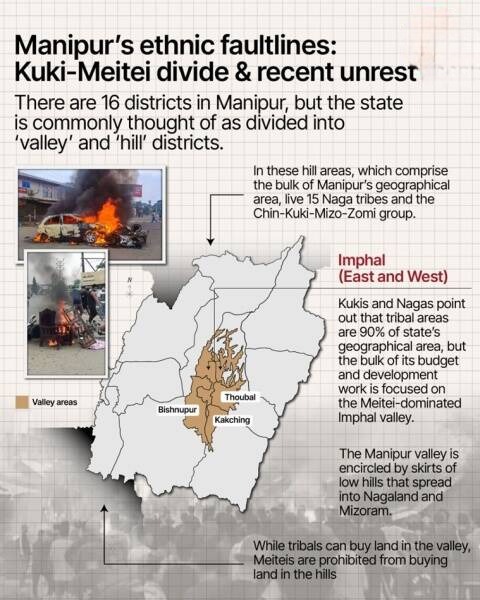Manipur’s Communal Clash: Seeking Consensus for Peaceful Resolution
Context:
The ongoing communal clash between the Kuki and Meitei communities in Manipur has resulted in a tragic and prolonged conflict, underscoring the futility of media debates, political posturing, and empty promises when it comes to resolving deadly conflicts.
Relevance:
GS-02 (Issues related to Minorities, SC’s and ST’s) (Poverty and development)
Prelims:
- Meitei tribes, Kuki tribes, Naga tribes.
- 6th Schedule
- Bhuria commission
- Xaxa Committee
Mains Questions:
- Analyze the geographical factors influencing the communal conflict in Manipur and its implications on the state’s integrity. (150 words)
The Process of Inclusion in the Scheduled Tribes (ST) List:
- State governments initiate the process by recommending tribes for inclusion in the ST list.
- Tribal Affairs Ministry examines the recommendations received from the state governments. These recommendations are then forwarded to the Registrar General of India, operating under the Home Ministry, for further scrutiny and approval.
- Once approved by the Registrar General of India, the recommendations are forwarded to the National Commission for Scheduled Tribes.
- After thorough consideration by the National Commission for Scheduled Tribes, the recommendations are presented to the Cabinet for a final decision.
- If the Cabinet approves the recommendations, it initiates the process of amending the Constitution (Scheduled Castes) Order, 1950, and the Constitution (Scheduled Tribes) Order, 1950.
- Once the amendment bill is passed by both houses of Parliament, it is forwarded to the President’s office. The President, acting under the authority of Articles 341 and 342 of the Constitution, takes the final decision on the inclusion of tribes in the ST list.
Dimensions of the article:
- Interlink in Mutual Welfare
- Meiteis’ Territorial Integrity and Historical Context
- Acknowledging Meitei Pain and Ethnic Cleansing
- Meitei Society’s Violent Response and Root Causes
- Kukis’ Grievances and Path to Normalcy
Interlink in Mutual Welfare
- The interdependence between Manipur’s hills and valleys has a significant bearing on the welfare of both regions.
- Geographical factors such as the integral geography of hills, valleys, rivers, and lakes create shared destinies and make any disruption to this integrity a potential threat to the sense of security of different communities.
- Scholars like Robert D. Kaplan and Halford J. Mackinder have highlighted how conflicts rooted in shared geographical destinies have unfolded throughout history.
- Recognizing the mutual dependence of Manipur’s hills and valleys is crucial in understanding the dynamics of the current standoff.
Meiteis’ Territorial Integrity and Historical Context
- The Meitei community’s deep concern for Manipur’s territorial integrity can be traced back to historical factors.
- The British introduction of a skewed land law, inherited by independent India, led to the confinement of the Meiteis in the small Imphal Valley. The British, faced with “non-state bearing” populations in the surrounding hills, chose to associate with the centralized bureaucracies of the “Paddy States” rather than subjugate each community individually. This governance mechanism, including the Bengal Eastern Frontier Regulation of 1873, was implemented in Manipur as well.
- The Meiteis’ demand for Scheduled Tribe (ST) status can be seen as a response to the sense of confinement and besiegement they have endured over the years.
Acknowledging Meitei Pain and Ethnic Cleansing
- While there is a focus on the ethnic cleansing happening in Manipur due to the recent conflict, it is crucial to recognize the silent and seemingly non-aggressive ethnic cleansing of Meiteis from Manipur’s hills since India’s Independence.
- The pain and humiliation faced by the Meiteis, along with the displaced individuals affected by the present crisis, need to be acknowledged.
- The demand for ST status serves as a desperate plea against this sense of besiegement, emphasizing the accumulated suffering endured by the Meiteis.
Meitei Society’s Violent Response and Root Causes
- The shocking and indiscriminate violence exhibited by the Meiteis following the events of May 3 in the Torbung area of Churachandpur district requires deeper analysis. It goes beyond the actions of a few organizations involved in the crisis. This surge of violence reflects a primordial, malevolent, and infantile force within Meitei society, breaking the bounds of civilizational control.
- The inability of the rational ego to exert influence contributes to the readiness to kill or die, showcasing the profound mobilization of the entire community. The situation echoes W.B. Yeats’ famous line, “A terrible beauty is born,” blurring the distinction between beauty and beastliness.
Kukis’ Grievances and Path to Normalcy
- The Kuki community has also endured long-standing grievances and a sense of persecution resulting from policies targeting poppy plantations, illegal migration, and encroachment into reserved forests.
- While it is important to acknowledge these concerns, it is crucial to prioritize the restoration of normalcy rather than engaging in finger-pointing.
- Leadership at the highest level should take the initiative to halt the ongoing conflict, while measures such as providing conclusive evidence of the withdrawal of Kuki militants and recovering looted weapons from police stations can help restore trust and facilitate the return to peace.
- Taking inspiration from Mahatma Gandhi’s decision to call off the Non-Cooperation Movement after the violent Chouri Choura incident, leaders must demonstrate courage and prioritize the well-being of all communities.
Way Forward:
It is essential to establish a framework of dialogue and consensus-building involving all stakeholders, including the Kukis and Meiteis. Structural administrative changes that are agreeable to all parties should be considered to address the underlying issues contributing to the conflict. The restoration of peace and the safe return of displaced individuals should be the primary focus, necessitating comprehensive measures to alleviate the suffering and facilitate reconciliation.
Conclusion:
The ongoing communal clash in Manipur underscores the urgency of finding a peaceful resolution that considers the interlink between communities, historical grievances, and territorial integrity. The complexity of the conflict demands a holistic approach with a focus on consensus-building, acknowledging the pain of all affected parties, and addressing the root causes of the violence. By prioritizing dialogue, understanding, and compassion, Manipur can pave the way for a harmonious future where all communities can thrive together.





